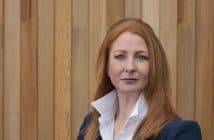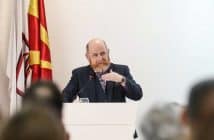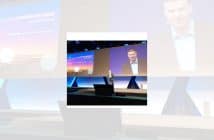Wind Energy has emerged as one of the cleanest, safest and most cost effective forms of energy. We speak with the team behind Templederry, Ireland’s first community-owned wind farm, about their tumultuous journey, and huge success.
Growing concerns around climate change, energy security and increasing fossil fuel prices has resulted in a need for Ireland to develop sustainable and indigenous energy resources. We have been given a target by the EU for 16% of our energy to come from renewable energy sources by 2020, and with this in mind, many are turning to wind energy as a solution. Proven to be one of the cleanest and most cost effective forms of energy production there remains a small percentage of the population who are wary of the development of wind farms. It is the pioneering mindset of the team behind Templederry, the only community-owned wind farm in the country, who are helping to change the tide of naysayers, and show that it is entirely possible for communities to generate enough wind energy for their locality, without causing unrest within the population.
The team behind Templederry had a long road to travel before their project came into being. Director of Templederry Wind Farm, John Fogarty, led the team from its inception. “Back in 1999, a group of us came together with an intention to draw up a plan for the community that would maximise whatever potential it might have,” he explains. “We carried out a development plan with the help of Professor Tom Collins, and we were taken with the idea of renewable energy.”
So began a journey that took almost ten years to come into fruition. After deciding on renewable energy as a viable option for their community, the group teamed up with the Tipperary Energy Agency to carry out a feasibility study, of which wind energy appeared to be the most sensible option. “The TEA was newly formed at the time and the director Seamus Hoyne was a huge boost to the project,” asserts Fogarty. “He had a combination of enthusiasm and ability that allowed him to drive the project forward. At the time, the planners were concerned that the skyline would be obstructed, so we chose a small hill with a higher hill behind it, that was still exposed to the prevailing winds. “
The group set up a dedicated wind development company, Templederry Wind Farm Ltd, and invited the community to become shareholders. They were at pains to point out the risks involved, given the fact that wind energy was a new concept to most, and looked for an initial capital investment of €1,000. Thirty equal shareholders came together. Money in place, they submitted a planning application and planning was granted in 2003. The next step was to apply for a grid connection to connect the wind farm to the national grid. Though a few wind farms had started to come on stream, the ESB chose to announce an indefinite moratorium on grid connections, to give it a chance to update infrastructure and technology. This was to be the first of many speed bumps for the project.
The moratorium lasted for three and a half years, and between this and the two year delivery time on wind turbines, the group had to reapply for planning permission. This time, they ran into some objectors. North Tipperary County Council granted the group planning permission for the second time in June 2007, which was appealed by the objectors to Bord Pleanála. “It was difficult to keep momentum going,” Fogarty admits. “We had to let the whole thing sit, updating everyone at the AGMs, and try to keep everyone enthusiastic. We were fortunate that our shareholders were so determained and that our steering group of four, which also included John Power, Pat O’Donoghue and Noel Carey had such great faith in the project”. Paul Kenny of Tipperary Energy Agency believes that John Fogarty was the linchpin that kept the project going. “With stuff like this everyone gets a down period and it’s good to have a couple of different people involved so that when someone gets disheartened there are lots of others to help them through. John is a unique individual and is hands down the most important person in terms of keeping this project going. “
Paul Kenny, CEO Tipperary Energy Agency,
Minister Pat Rabbitte and John Fogarty, Chairman templederry Community Windfarm.
In 2007, thesecond planning was appealed to Bord Pleanála. At the time, Ireland was at the height of the Celtic Tiger, and the backlog of planning applications meant that it was two years and three months before planning was eventually granted on the project. Between the moratorium on grid connections and planning issues, the project lost almost six years in development. Nobody could have predicted the financial crisis that would sweep the globe, and threaten the financing of Templederry Windfarm.
With the Celtic Tiger in crisis, and the world recession in full swing, financing the project became the final mountain for the team to climb. After their initial banking deal fell through, Enercon, the company behind Templederry’s wind turbines, stepped in to lend a hand. “They knew that this was going to be a problem generally for the industry.
They put us in contact with De Lage Landen, a subsidiary of Rabobank, and they worked out a financing package with us and Enercon, ” explains Fogarty. “Without Enercon’s backing and support, we would never have gotten where we are today.” At that stage, a bank would only loan a project a certain amount of the capital, and for the remaining money, the group looked to a BES scheme. “In 2011 people didn’t want to invest until they could see how it was going to work out, so we went to a BES investment house, and that worked out for us” explains Fogarty. They were quite glad to get a wind scheme with other financing in place. The great thing about a wind farm from a BES point of view, is that once it’s in production, you have a power purchase agreement for fifteen years, so you know the product you are buying into will be sold for that length of time without any issues. It really is a bankers deal, once the construction is underway.”
With money finally secured, a positive end was in sight for the company. “In January we had our final meeting in terms of getting construction underway, and Enercon told us that the turbines would arrive on the17th of September” a palpably relieved Fogarty says. “Nine months later, at 5am in the morning, those turbines came around the corner, exactly as promised. The pleasure in dealing with a company like that can’t be measured.” Today, Templederry wind farm is home to two turbines. Those turbines power 3500 homes, producing over double what their original counterparts would have provided.
Despite the obvious success of the Templederry project, there is a growing sense of unrest around the country when it comes to wind energy, mostly at the hands of large-scale developments in the midlands. John Fogarty is clear on what needs to happen. It would be lovely to see Ireland as an exporter of green energy, and becoming independent of the world oil market, but if these big developments go ahead, that they create space for small community owned developments within them. The key is that a large amount of the money should stay within the community. What we hope is that the government would streamline some of it. If a community came together and worked with the planners, we might be able to find a solution that suits everyone.”
Is wind energy the solution to our energy crisis? There is no doubt in Paul Kenny’s mind. “There’s a couple of reasons why Ireland needs to do something about the energy it is using,” he speculates. “One is that carbon fuel is having a serious impact on the planet, and the second thing is the cost of the energy we are dependent on. Whether it’s from a fiscal or climate perspective we need to do the same thing, and that is, take our economy away from fossil fuels. If you want to live in a country with a reliable, secure and cost effective energy supply, then we are going to need wind. The bottom line is that the negative lobby has been driven by fear of the very big projects that have very little community input or gain. There was no issue before the big projects came on stream, and what people are attacking is wind energy, but what they should be attacking is corporate dominance over our energy supplies.”
Roll Call
The team behind Templederry would like to express their gratitude to the following people, without whom, the wind farm would not be the success it is today.
Prof Tom Collins for creating the development plan.
Tippearary Energy Agency, and in particular, Seamus Hoyne and Paul Kenny and Paddy Phelan for their endless enthusiasm and support. North Tipperary County Council for all their help.
North Tipperary Leader Partnership: Patrick Killeen, Sean Crowley Gearoid Fitzgibbon and Ronan Gleeson
Focus Consulting in particular : John English
Electric Ireland for improving infrastructure and their help along the way. In particular: Noel Cowhey, Tom Butler, Karen Coady, Mary Power, John Corcoran, Mike Malone and Billy Maher.
Wind Prospect Ireland, in particular: Ciaran Donnelly, Colette Hickey, Peter King
Jennings O’Donovan, in particular Mel Gavin
Enercon and in particular, Robin Borgert and Karen Rock
De Lage Landon and BDO Investment
This article first appeared in the December 2013 issue of Irish Building Magazine.





